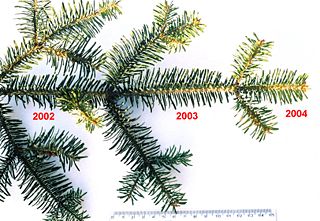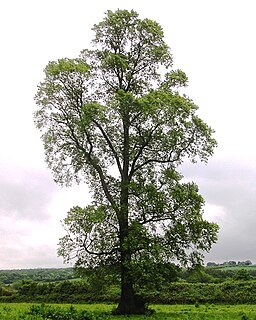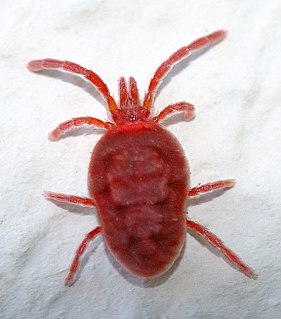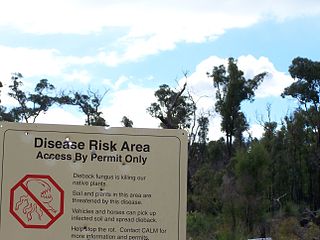Related Research Articles

Ascomycota is a phylum of the kingdom Fungi that, together with the Basidiomycota, forms the subkingdom Dikarya. Its members are commonly known as the sac fungi or ascomycetes. It is the largest phylum of Fungi, with over 64,000 species. The defining feature of this fungal group is the "ascus", a microscopic sexual structure in which nonmotile spores, called ascospores, are formed. However, some species of the Ascomycota are asexual, meaning that they do not have a sexual cycle and thus do not form asci or ascospores. Familiar examples of sac fungi include morels, truffles, brewers' and bakers' yeast, dead man's fingers, and cup fungi. The fungal symbionts in the majority of lichens such as Cladonia belong to the Ascomycota.

In agriculture, monoculture is the practice of growing one crop species in a field at a time. Monoculture is widely used in intensive farming and in organic farming: both a 1,000-acre cornfield and a 10-hectare field of organic kale are monocultures. Monoculture crops have allowed farmers to increase efficiency in planting, managing, and harvesting, mainly by facilitating the use of machinery in these operations, but monocultures can also increase the risk of diseases or pest outbreaks. Diversity can be added both in time, as with a crop rotation or sequence, or in space, with a polyculture or intercropping.

Rusts are plant diseases caused by pathogenic fungi of the order Pucciniales.

In botany, an evergreen is a plant which has foliage that remains green and functional through more than one growing season. This also pertains to plants that retain their foliage only in warm climates, and contrasts with deciduous plants, which completely lose their foliage during the winter or dry season.

Elms are deciduous and semi-deciduous trees comprising the flowering plant genus Ulmus in the plant family Ulmaceae. The genus first appeared in the Miocene geological period about 20 million years ago, originating in what is now central Asia. These trees flourished and spread over most of the Northern Hemisphere, inhabiting the temperate and tropical-montane regions of North America and Eurasia, presently ranging southward in the Middle East to Lebanon, and Israel, and across the Equator in the Far East into Indonesia.

Plant pathology is the scientific study of diseases in plants caused by pathogens and environmental conditions. Organisms that cause infectious disease include fungi, oomycetes, bacteria, viruses, viroids, virus-like organisms, phytoplasmas, protozoa, nematodes and parasitic plants. Not included are ectoparasites like insects, mites, vertebrate, or other pests that affect plant health by eating plant tissues. Plant pathology also involves the study of pathogen identification, disease etiology, disease cycles, economic impact, plant disease epidemiology, plant disease resistance, how plant diseases affect humans and animals, pathosystem genetics, and management of plant diseases.

Mites are small arachnids. Mites span two large orders of arachnids, the Acariformes and the Parasitiformes, which were historically grouped together in the subclass Acari, but genetic evidence suggests are not closely related. The Parasitiformes include ticks, which are sometimes semantically distinguished from mites.

Commonly known as hellebores, the Eurasian genus Helleborus consists of approximately 20 species of herbaceous or evergreen perennial flowering plants in the family Ranunculaceae, within which it gave its name to the tribe of Helleboreae. Despite names such as "winter rose", "Christmas rose" and "Lenten rose", hellebores are not closely related to the rose family (Rosaceae). Many hellebore species are poisonous.

Pinus thunbergii, also called black pine, Japanese black pine, and Japanese pine, is a pine tree native to coastal areas of Japan and South Korea.

Phytophthora cinnamomi is a soil-borne water mould that produces an infection which causes a condition in plants variously called "root rot", "dieback", or, "ink disease". The plant pathogen is one of the world's most invasive species and is present in over 70 countries around the world.

Stilbenoids are hydroxylated derivatives of stilbene. They have a C6–C2–C6 structure. In biochemical terms, they belong to the family of phenylpropanoids and share most of their biosynthesis pathway with chalcones. Most stilbenoids are produced by plants, and the only known exception is the antihelminthic and antimicrobial stilbenoid, 2-isopropyl-5-[(E)-2-phenylvinyl]benzene-1,3-diol, biosynthesized by the Gram-negative bacterium Photorhabdus luminescens.
Xylophilus ampelinus is a species of bacteria that can cause plant disease. It is available from the NCPPB in the United Kingdom and other international culture collections such as ICMP in New Zealand, and LMG in Belgium.

Bursaphelenchus xylophilus, commonly known as pine wood nematode or pine wilt nematode (PWN), is a species of nematode that infects trees in the Pinus genus of coniferous trees and causes the disease pine wilt. While native to North America, it spread in the early 20th century to Japan and in the latter half of the century to other areas of Asia, including China, Taiwan and Korea, as well as to Europe, including Portugal and Spain.

The nematodes or roundworms constitute the phylum Nematoda, with plant-parasitic nematodes also known as eelworms. They are a diverse animal phylum inhabiting a broad range of environments. Taxonomically, they are classified along with insects and other moulting animals in the clade Ecdysozoa, and unlike flatworms, have tubular digestive systems with openings at both ends. Like tardigrades, they have a reduced number of Hox genes, but their sister phylum Nematomorpha has kept the ancestral protostome Hox genotype, which shows that the reduction has occurred within the nematode phylum.

Bursaphelenchus is a genus of nematodes (roundworms) in the order Aphelenchida. Most are obligate mycophages, but some feed on wood, with two species, the red ring nematode and the pine wood nematode, economically significant as pests of coconut palms and of pine trees, respectively. Given that Bursaphelenchus species are usually hard to distinguish from one another except by trained nematologists with access to microscopes or DNA sequence analysis, the entire genus is put under quarantine in some countries. Where this is not the case however, these nematodes are becoming established as model organisms for nematode developmental biology, ecology and genetics.
The red ring disease of coconuts and African oil palms is caused by the nematode Bursaphelenchus cocophilus. It is also identified in literature with an alternative scientific name Rhadinaphelenchus cocophilus. The common name, the red ring nematode, is derived from its distinguishing symptom.
In biology, a pathogen in the oldest and broadest sense, is any organism that can produce disease. A pathogen may also be referred to as an infectious agent, or simply a germ.

Monochamus galloprovincialis, the pine sawyer beetle, also referred to as the black pine sawyer beetle, is a species of beetle in the family Cerambycidae. It was described by Olivier in 1795, originally under the genus Cerambyx. It has a wide distribution, occurring naturally throughout Europe and the Caucasus. It has also been introduced into the Canary Islands. It serves as a vector for the parasitic nematode species Bursaphelenchus xylophilus, and also acts as a host to the parasitoid wasp species Dolichomitus tuberculatus.

Xylophilus luniger is a beetle that is endemic to New Zealand. This member of the family Aderidae is commonly collected by beating vegetation around the margins of native forest. The species has been collected in the North Island only.
Xylophilus is a genus of beetles belonging to the family Eucnemidae.
References
- 1 2 3 Parte, A.C. "Xylophilus". LPSN .